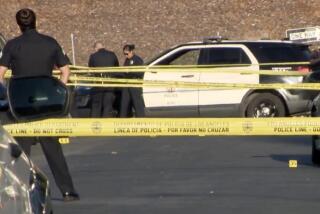Racial hatred blamed in girl’s slaying in Harbor Gateway area
- Share via
One moment, it was an idyllic December afternoon with a group of young people hanging out in the driveway, one young man showing his 6-year-old cousin how to play Tetris on a cellphone.
In the next, a gunman walked up and began firing into the crowd, sending people screaming and running, leaving a 14-year-old girl dead and others injured.
What led to the 2006 death of Cheryl Green was not a calculated crime but an indiscriminate racial hatred that has long plagued a narrow strip of Los Angeles squeezed between Torrance and Carson, known as the Harbor Gateway area, a prosecutor said Wednesday.
In opening statements in the trial of two Latino gang members charged in the murders of Cheryl Green and a potential witness, prosecutors described the racially charged environment of the Harbor Gateway area that led to the girl’s death. The slaying sparked outrage and highlighted long-standing black-Latino tensions in the neighborhood.
It was a world in which intimidating and killing blacks was a “full-time enterprise” for powerful Latino gangs, and walls covered in graffiti with racial epithets made it abundantly clear that blacks were not welcome in the area, Deputy Dist. Atty. Gretchen Ford told jurors.
Jonathan Fajardo, now 22, faces the death penalty if convicted of Green’s murder. Fajardo and a second defendant, Daniel Aguilar, 23, are also accused in the stabbing death of a potential witness, a fellow gang member whom they suspected of talking to the police shortly after the shooting. Aguilar is not charged in Green’s killing.
Ford said the chain of events began with a black man driving up in an SUV to a market in the area that members of the 204th Street gang frequented. When Fajardo and others approached the car, the man flashed a gun, and the gang members, who were unarmed, fled.
Fajardo, angry over the confrontation, retrieved a gun from a friend’s apartment and later opened fire on Green and her friends because they were black, Ford alleged.
Green died at the scene. Three others suffered gunshot wounds but survived.
Police, suspecting that the 204th Street gang was involved because the shooting had targeted blacks, served search warrants on known gang hangouts, one of which was the apartment of Christopher Ash. When Ash was arrested but released later the same day, the gang began “gossiping” that he might have been cooperating with the police, Ford said.
Gang members lured Ash to a garage, where they took turns stabbing him, Ford told the jury.
Ash’s body, stabbed 80 times and with his throat slit, was found on the side of a road in Carson two weeks after Green’s death.
Ford said Fajardo, in a lengthy statement to police, admitted to Green’s killing and to suspecting Ash of being a snitch. He believed that Ash, the only non-Latino member of the gang, kept a diary about the gang’s dealings, Ford said.
Thomas White, Fajardo’s defense attorney, challenged Ford’s characterization of the group of youngsters that Green was with, saying they were drinking and smoking marijuana. He said the gunman did not specifically target Green.
He also said his client believed the group intended to confront Ash, not kill him.
Aguilar’s attorney contended that his client just did as he was told by older gang members, “big homies,” because he feared the consequences if he refused.
Green’s mother, Charlene Lovett, sat in the audience with other family members and sobbed upon hearing the scene of her daughter’s death described.
“It’s something that a mother should never have to envision in their mind, their child getting killed,” she later said outside court. “It’s horrible.”
victoria.kim@latimes.com











